sensor KIA K900 2015 1.G Owner's Guide
[x] Cancel search | Manufacturer: KIA, Model Year: 2015, Model line: K900, Model: KIA K900 2015 1.GPages: 522, PDF Size: 7.92 MB
Page 325 of 522
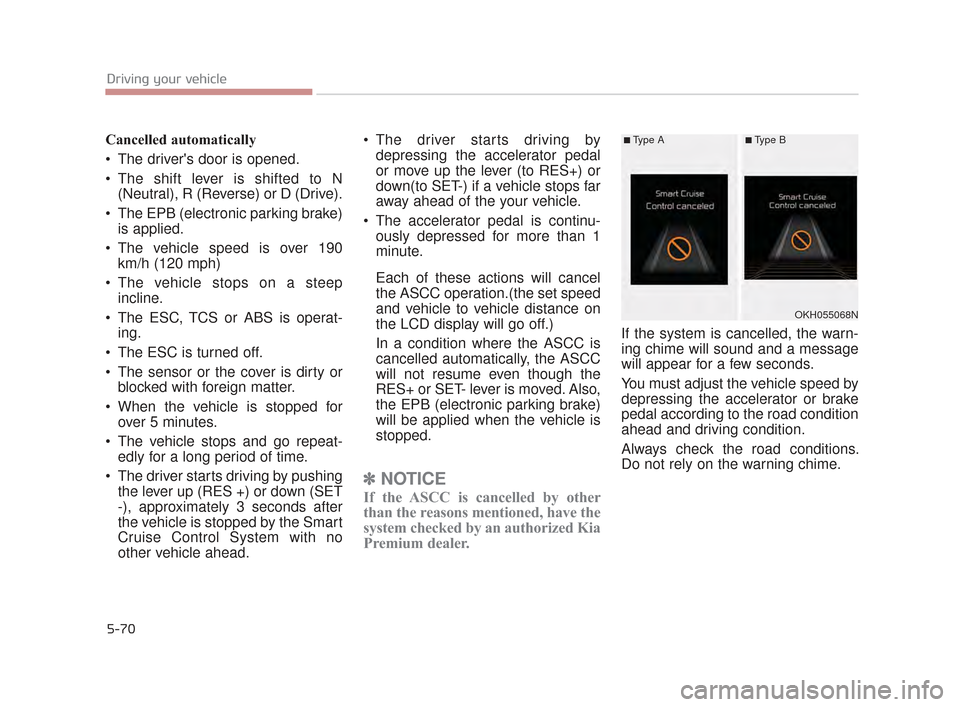
5-70
Driving your vehicle
Cancelled automatically
The driver's door is opened.
The shift lever is shifted to N(Neutral), R (Reverse) or D (Drive).
The EPB (electronic parking brake) is applied.
The vehicle speed is over 190 km/h (120 mph)
The vehicle stops on a steep incline.
The ESC, TCS or ABS is operat- ing.
The ESC is turned off.
The sensor or the cover is dirty or blocked with foreign matter.
When the vehicle is stopped for over 5 minutes.
The vehicle stops and go repeat- edly for a long period of time.
The driver starts driving by pushing the lever up (RES +) or down (SET
-), approximately 3 seconds after
the vehicle is stopped by the Smart
Cruise Control System with no
other vehicle ahead. The driver starts driving by
depressing the accelerator pedal
or move up the lever (to RES+) or
down(to SET-) if a vehicle stops far
away ahead of the your vehicle.
The accelerator pedal is continu- ously depressed for more than 1
minute.
Each of these actions will cancel
the ASCC operation.(the set speed
and vehicle to vehicle distance on
the LCD display will go off.)
In a condition where the ASCC is
cancelled automatically, the ASCC
will not resume even though the
RES+ or SET- lever is moved. Also,
the EPB (electronic parking brake)
will be applied when the vehicle is
stopped.
✽ NOTICE
If the ASCC is cancelled by other
than the reasons mentioned, have the
system checked by an authorized Kia
Premium dealer.
If the system is cancelled, the warn-
ing chime will sound and a message
will appear for a few seconds.
You must adjust the vehicle speed by
depressing the accelerator or brake
pedal according to the road condition
ahead and driving condition.
Always check the road conditions.
Do not rely on the warning chime.
OKH055068N
■Type A■Type B
KH CAN (ENG) 5:2015 3/25/2015 10:52 AM Page 70
Page 329 of 522
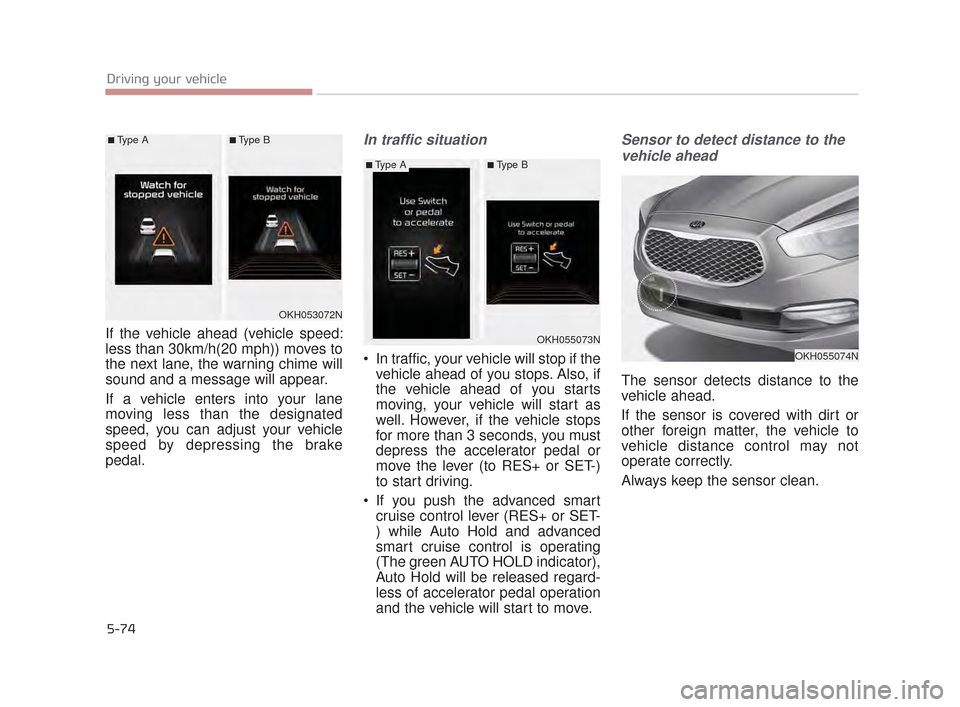
5-74
Driving your vehicle
If the vehicle ahead (vehicle speed:
less than 30km/h(20 mph)) moves to
the next lane, the warning chime will
sound and a message will appear.
If a vehicle enters into your lane
moving less than the designated
speed, you can adjust your vehicle
speed by depressing the brake
pedal.
In traffic situation
In traffic, your vehicle will stop if thevehicle ahead of you stops. Also, if
the vehicle ahead of you starts
moving, your vehicle will start as
well. However, if the vehicle stops
for more than 3 seconds, you must
depress the accelerator pedal or
move the lever (to RES+ or SET-)
to start driving.
If you push the advanced smart cruise control lever (RES+ or SET-
) while Auto Hold and advanced
smart cruise control is operating
(The green AUTO HOLD indicator),
Auto Hold will be released regard-
less of accelerator pedal operation
and the vehicle will start to move.
Sensor to detect distance to the
vehicle ahead
The sensor detects distance to the
vehicle ahead.
If the sensor is covered with dirt or
other foreign matter, the vehicle to
vehicle distance control may not
operate correctly.
Always keep the sensor clean.
OKH053072N
■Type A■Type B
OKH055073N
OKH055074N
■Type A■Type B
KH CAN (ENG) 5:2015 3/25/2015 10:53 AM Page 74
Page 330 of 522
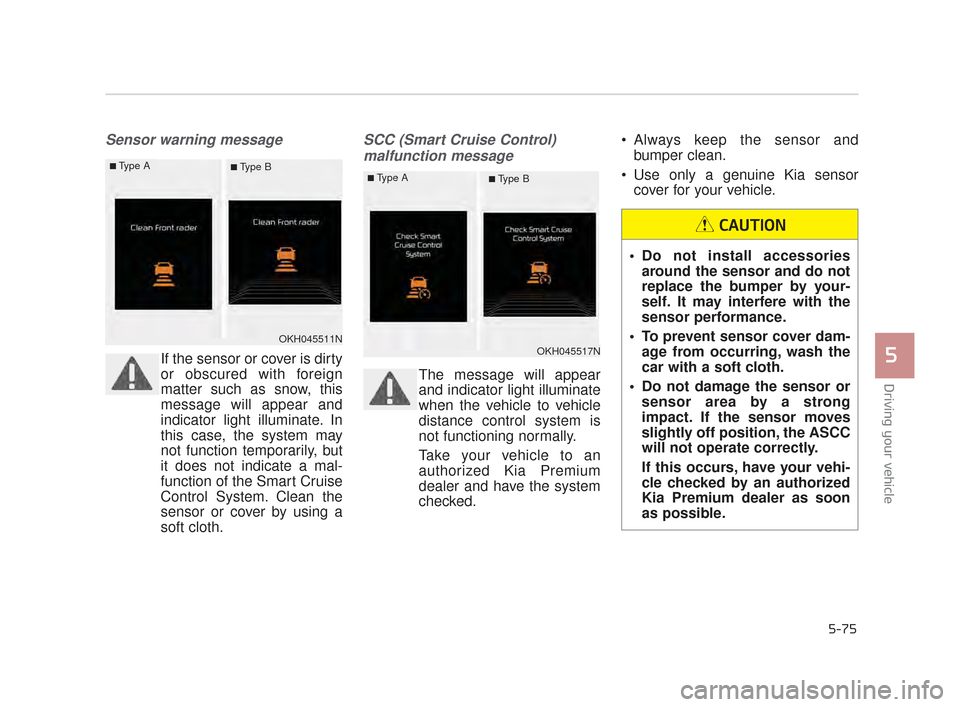
Driving your vehicle
5
5-75
Sensor warning message
If the sensor or cover is dirty
or obscured with foreign
matter such as snow, this
message will appear and
indicator light illuminate. In
this case, the system may
not function temporarily, but
it does not indicate a mal-
function of the Smart Cruise
Control System. Clean the
sensor or cover by using a
soft cloth.
SCC (Smart Cruise Control) malfunction message
The message will appear
and indicator light illuminate
when the vehicle to vehicle
distance control system is
not functioning normally.
Take your vehicle to an
authorized Kia Premium
dealer and have the system
checked. Always keep the sensor and
bumper clean.
Use only a genuine Kia sensor cover for your vehicle.
Do not install accessoriesaround the sensor and do not
replace the bumper by your-
self. It may interfere with the
sensor performance.
To prevent sensor cover dam- age from occurring, wash the
car with a soft cloth.
Do not damage the sensor or sensor area by a strong
impact. If the sensor moves
slightly off position, the ASCC
will not operate correctly.
If this occurs, have your vehi-
cle checked by an authorized
Kia Premium dealer as soon
as possible.
CAUTION
OKH045511NOKH045517N
■Type A■ Type B■Type A■ Type B
KH CAN (ENG) 5:2015 3/25/2015 10:53 AM Page 75
Page 333 of 522

5-78
Driving your vehicle
Lane changing
A vehicle which moves into yourlane from an adjacent lane cannot
be recognized by the sensor until it
is in the sensor's detection range.
The sensor may not detect imme- diately when a vehicle cuts in sud-
denly. Always pay attention to the
traffic, road and driving conditions.
If a vehicle which moves into your lane is slower than your vehicle,
your speed may decrease to main-
tain the distance to the vehicle
ahead. If a vehicle which moves into your
lane is faster than your vehicle,
your vehicle will accelerate to the
selected speed.
Your vehicle may accelerate whena vehicle ahead of you disappears.
When you are warned that the vehicle ahead of you is not detect-
ed, drive with caution.
OKH053203N
OKH053204N
KH CAN (ENG) 5:2015 3/25/2015 10:53 AM Page 78
Page 334 of 522

Driving your vehicle
5
5-79
Vehicle recognition
Some vehicles ahead in your lane
cannot be recognized by the sensor
as follows:
- Narrow vehicles such as motorcy-cles or bicycles
- Vehicles offset to one side
- Slow-moving vehicles or sudden- decelerating vehicles
- Stopped vehicles
- Vehicles with small rear profile such as trailers with no loads A vehicle ahead cannot be recog-
nized correctly by the sensor if any of
following occurs:
- When the vehicle is pointing
upwards due to overloading in the
trunk
- While making turns by steering
- When driving to one side of the lane
- When driving on narrow lanes or on curves
Adjust your vehicle speed by
depressing the brake pedal accord-
ing to the road condition ahead and
driving condition. When vehicles are at a standstill
and the vehicle in front of you
changes to the next lane, be care-
ful when your vehicle starts to
move because it may not recog-
nize the stopped vehicle in front of
you.
OKH053205N
OKH053206N
KH CAN (ENG) 5:2015 3/25/2015 10:53 AM Page 79
Page 337 of 522
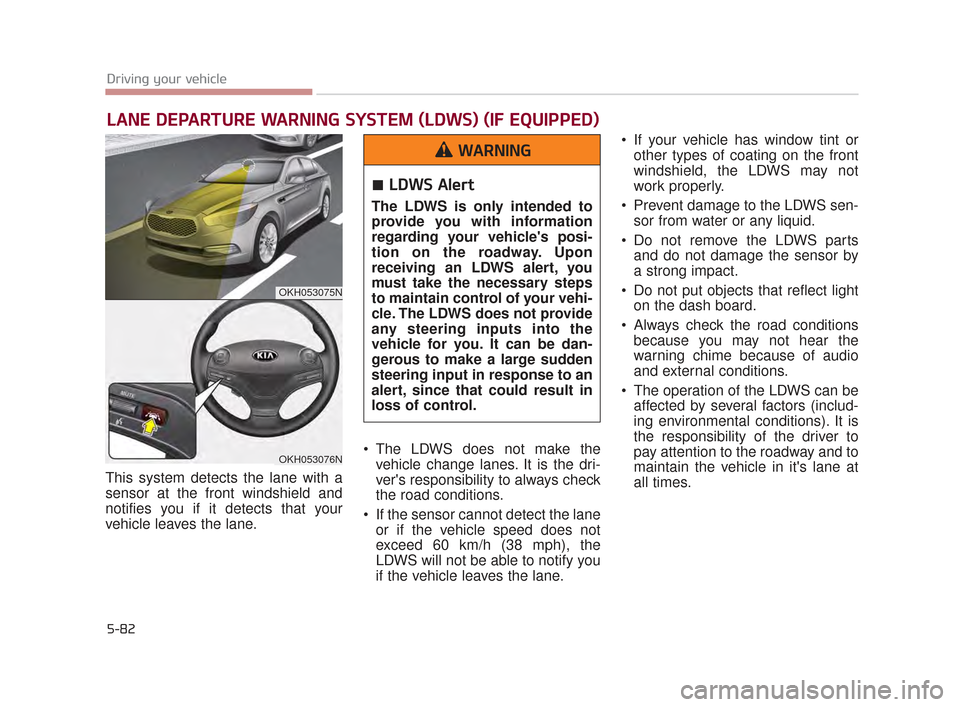
5-82
Driving your vehicle
This system detects the lane with a
sensor at the front windshield and
notifies you if it detects that your
vehicle leaves the lane. The LDWS does not make the
vehicle change lanes. It is the dri-
ver's responsibility to always check
the road conditions.
If the sensor cannot detect the lane or if the vehicle speed does not
exceed 60 km/h (38 mph), the
LDWS will not be able to notify you
if the vehicle leaves the lane. If your vehicle has window tint or
other types of coating on the front
windshield, the LDWS may not
work properly.
Prevent damage to the LDWS sen- sor from water or any liquid.
Do not remove the LDWS parts and do not damage the sensor by
a strong impact.
Do not put objects that reflect light on the dash board.
Always check the road conditions because you may not hear the
warning chime because of audio
and external conditions.
The operation of the LDWS can be affected by several factors (includ-
ing environmental conditions). It is
the responsibility of the driver to
pay attention to the roadway and to
maintain the vehicle in it's lane at
all times.
LANE DEPARTURE WARNING SYSTEM (LDWS) (IF EQUIPPED)
OKH053075N
OKH053076N
LDWS Alert
The LDWS is only intended to
provide you with information
regarding your vehicle's posi-
tion on the roadway. Upon
receiving an LDWS alert, you
must take the necessary steps
to maintain control of your vehi-
cle. The LDWS does not provide
any steering inputs into the
vehicle for you. It can be dan-
gerous to make a large sudden
steering input in response to an
alert, since that could result in
loss of control.
WARNING
KH CAN (ENG) 5:2015 3/25/2015 10:53 AM Page 82
Page 338 of 522
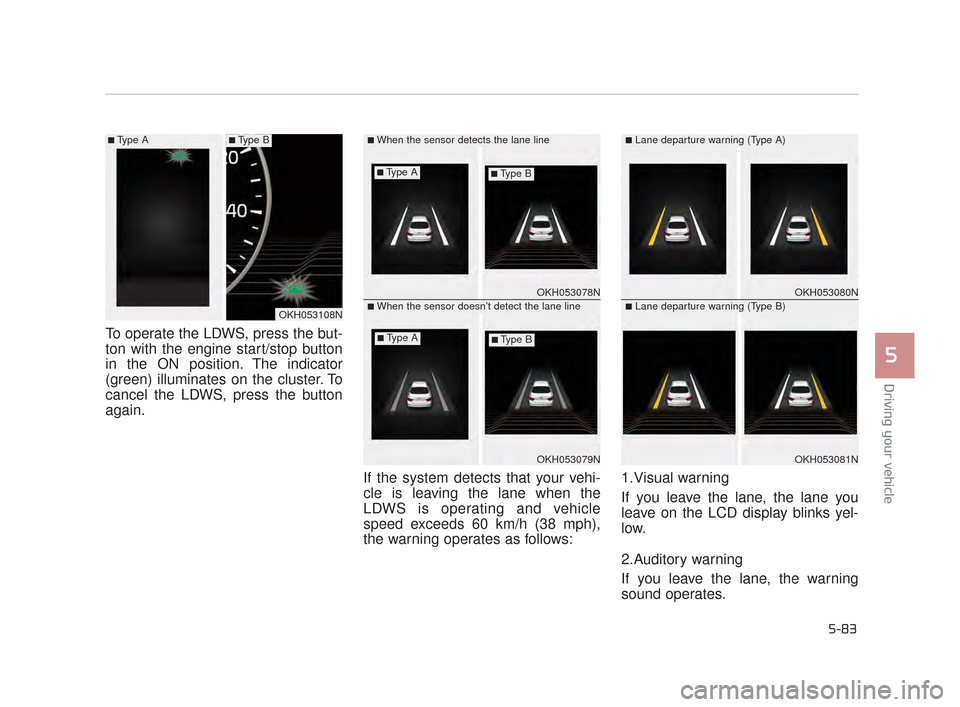
Driving your vehicle
5
5-83
To operate the LDWS, press the but-
ton with the engine start/stop button
in the ON position. The indicator
(green) illuminates on the cluster. To
cancel the LDWS, press the button
again.If the system detects that your vehi-
cle is leaving the lane when the
LDWS is operating and vehicle
speed exceeds 60 km/h (38 mph),
the warning operates as follows:1.Visual warning
If you leave the lane, the lane you
leave on the LCD display blinks yel-
low.
2.Auditory warning
If you leave the lane, the warning
sound operates.
OKH053078N
OKH053079N
■When the sensor detects the lane line
■When the sensor doesn’t detect the lane lineOKH053080N
OKH053081N
■Lane departure warning (Type A)
■Lane departure warning (Type B)OKH053108N
■Type A■Type B
■Type A■Type B
■Type A■Type B
KH CAN (ENG) 5:2015 3/25/2015 10:53 AM Page 83
Page 339 of 522
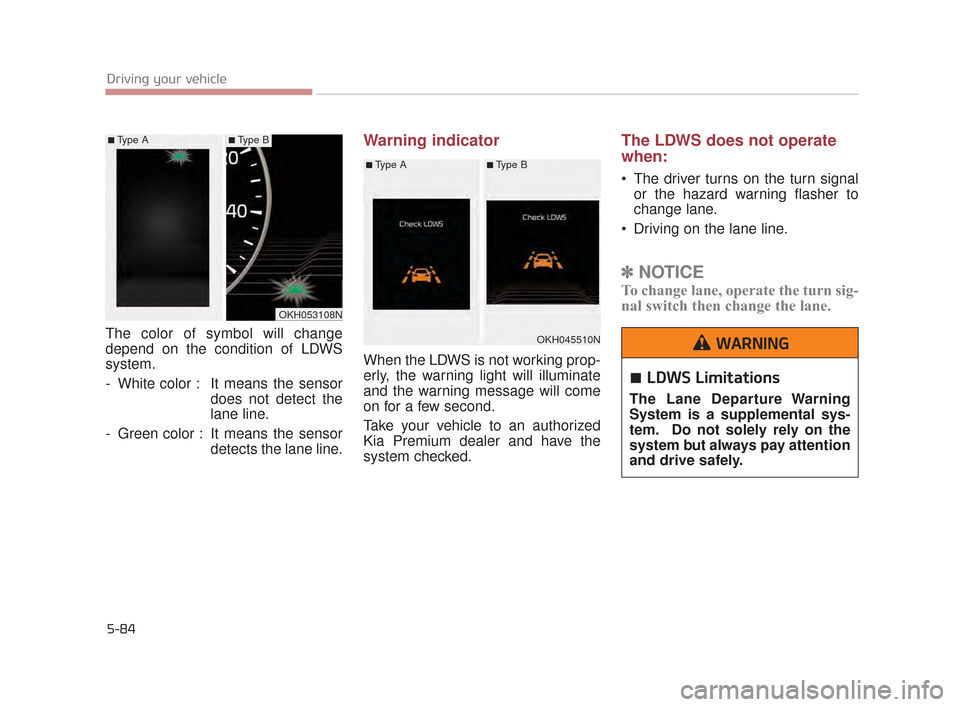
5-84
Driving your vehicle
The color of symbol will change
depend on the condition of LDWS
system.
- White color : It means the sensordoes not detect the
lane line.
- Green color : It means the sensor detects the lane line.
Warning indicator
When the LDWS is not working prop-
erly, the warning light will illuminate
and the warning message will come
on for a few second.
Take your vehicle to an authorized
Kia Premium dealer and have the
system checked.
The LDWS does not operate
when:
The driver turns on the turn signalor the hazard warning flasher to
change lane.
Driving on the lane line.
✽ NOTICE
To change lane, operate the turn sig-
nal switch then change the lane.
OKH053108N
■Type A■Type B
OKH045510N
■Type A■Type B
LDWS Limitations
The Lane Departure Warning
System is a supplemental sys-
tem. Do not solely rely on the
system but always pay attention
and drive safely.
WARNING
KH CAN (ENG) 5:2015 3/25/2015 10:53 AM Page 84
Page 340 of 522
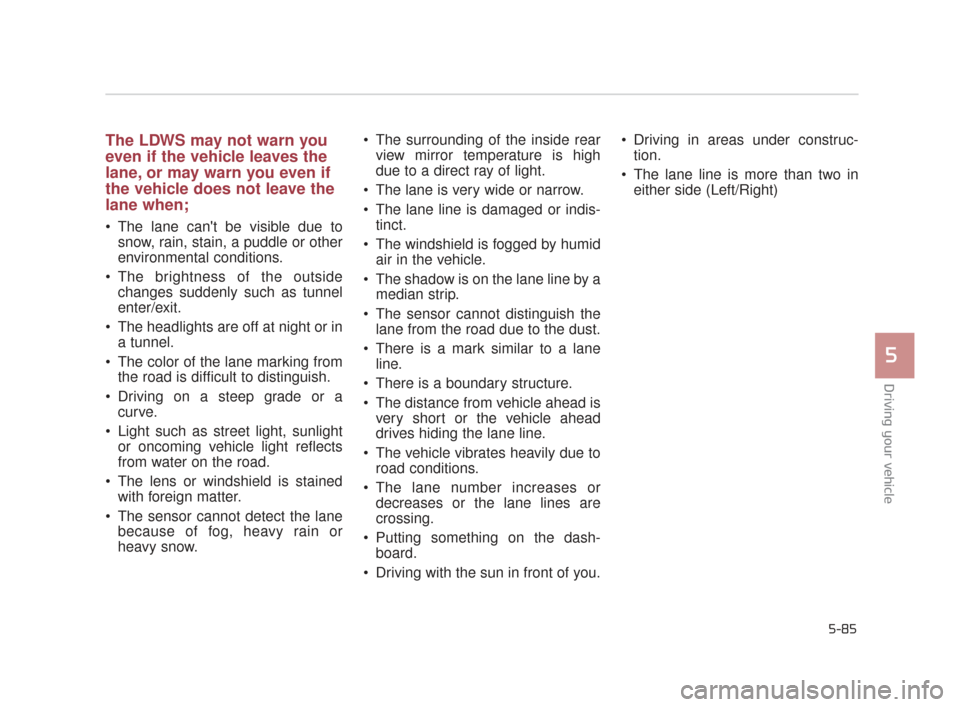
Driving your vehicle
5
5-85
The LDWS may not warn you
even if the vehicle leaves the
lane, or may warn you even if
the vehicle does not leave the
lane when;
The lane can't be visible due tosnow, rain, stain, a puddle or other
environmental conditions.
The brightness of the outside changes suddenly such as tunnel
enter/exit.
The headlights are off at night or in a tunnel.
The color of the lane marking from the road is difficult to distinguish.
Driving on a steep grade or a curve.
Light such as street light, sunlight or oncoming vehicle light reflects
from water on the road.
The lens or windshield is stained with foreign matter.
The sensor cannot detect the lane because of fog, heavy rain or
heavy snow. The surrounding of the inside rear
view mirror temperature is high
due to a direct ray of light.
The lane is very wide or narrow.
The lane line is damaged or indis- tinct.
The windshield is fogged by humid air in the vehicle.
The shadow is on the lane line by a median strip.
The sensor cannot distinguish the lane from the road due to the dust.
There is a mark similar to a lane line.
There is a boundary structure.
The distance from vehicle ahead is very short or the vehicle ahead
drives hiding the lane line.
The vehicle vibrates heavily due to road conditions.
The lane number increases or decreases or the lane lines are
crossing.
Putting something on the dash- board.
Driving with the sun in front of you. Driving in areas under construc-
tion.
The lane line is more than two in either side (Left/Right)
KH CAN (ENG) 5:2015 3/25/2015 10:53 AM Page 85
Page 341 of 522
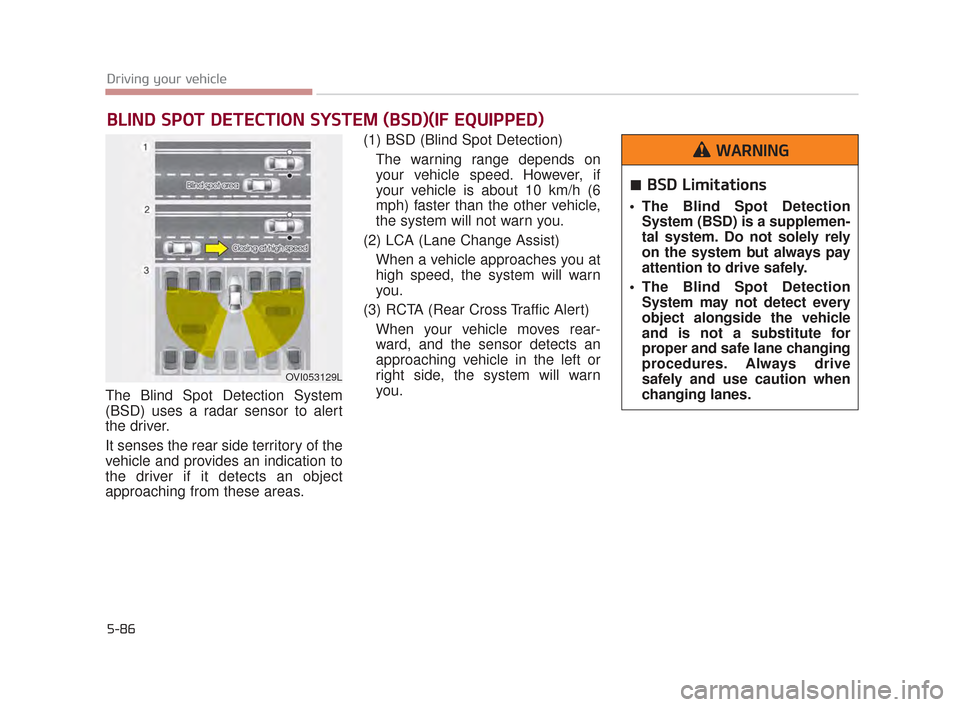
5-86
Driving your vehicle
The Blind Spot Detection System
(BSD) uses a radar sensor to alert
the driver.
It senses the rear side territory of the
vehicle and provides an indication to
the driver if it detects an object
approaching from these areas.(1) BSD (Blind Spot Detection)
The warning range depends on
your vehicle speed. However, if
your vehicle is about 10 km/h (6
mph) faster than the other vehicle,
the system will not warn you.
(2) LCA (Lane Change Assist) When a vehicle approaches you at
high speed, the system will warn
you.
(3) RCTA (Rear Cross Traffic Alert) When your vehicle moves rear-
ward, and the sensor detects an
approaching vehicle in the left or
right side, the system will warn
you.
BLIND SPOT DETECTION SYSTEM (BSD)(IF EQUIPPED)
OVI053129L
BSD Limitations
The Blind Spot DetectionSystem (BSD) is a supplemen-
tal system. Do not solely rely
on the system but always pay
attention to drive safely.
The Blind Spot Detection System may not detect every
object alongside the vehicle
and is not a substitute for
proper and safe lane changing
procedures. Always drive
safely and use caution when
changing lanes.
WARNING
KH CAN (ENG) 5:2015 3/25/2015 10:54 AM Page 86